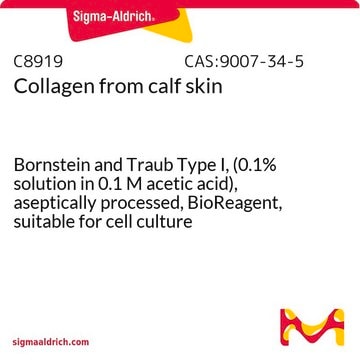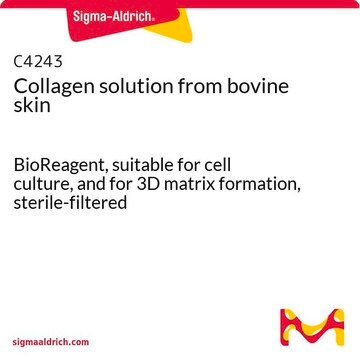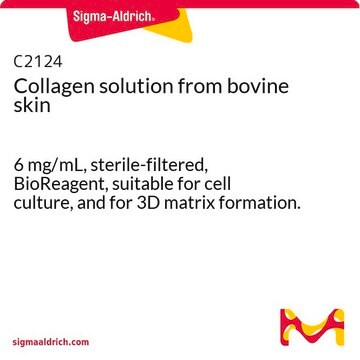C9791
Bovine Collagen Type I
from bovine skin, powder, suitable for cell culture
Synonyme(s) :
Type I collagen
About This Item
Produits recommandés
product name
Collagen from calf skin, Bornstein and Traub Type I, solid, BioReagent, suitable for cell culture
Source biologique
bovine (calf) skin
Gamme de produits
BioReagent
Forme
solid
Conditionnement
poly bottle of 10 mg
poly bottle of 100 mg
poly bottle of 250 mg
poly bottle of 50 mg
Technique(s)
cell culture | mammalian: suitable
Couverture de surface
6‑10 μg/cm2
Solubilité
0.1 M acetic acid: 1 mg/mL (Allow to stir at room temperature 1-3 hours until dissolved.)
Numéro d'accès UniProt
Spécificité de la liaison
Peptide Source: Fibronectin
Peptide Source: Laminin
Conditions d'expédition
ambient
Température de stockage
2-8°C
Informations sur le gène
bovine ... COL1A1(282187)
Vous recherchez des produits similaires ? Visite Guide de comparaison des produits
Catégories apparentées
Description générale
Application
- as a component of collagen gel matrix for culturing preantral follicles
- as a component of Roswell Park Memorial Institute, for culturing gilthead seabream kidney leukocytes and macrophages and acidophilic granulocytes
- to coat transwells prior to seeding of epithelial cell culture
Actions biochimiques/physiologiques
Composants
Notes préparatoires
Autres remarques
Code de la classe de stockage
11 - Combustible Solids
Classe de danger pour l'eau (WGK)
WGK 1
Point d'éclair (°F)
Not applicable
Point d'éclair (°C)
Not applicable
Équipement de protection individuelle
Eyeshields, Gloves, type N95 (US)
Certificats d'analyse (COA)
Recherchez un Certificats d'analyse (COA) en saisissant le numéro de lot du produit. Les numéros de lot figurent sur l'étiquette du produit après les mots "Lot" ou "Batch".
Déjà en possession de ce produit ?
Retrouvez la documentation relative aux produits que vous avez récemment achetés dans la Bibliothèque de documents.
Les clients ont également consulté
Articles
Extracellular matrix proteins such as laminin, collagen, and fibronectin can be used as cell attachment substrates in cell culture.
Cancer stem cell media, spheroid plates and cancer stem cell markers to culture and characterize CSC populations.
Notre équipe de scientifiques dispose d'une expérience dans tous les secteurs de la recherche, notamment en sciences de la vie, science des matériaux, synthèse chimique, chromatographie, analyse et dans de nombreux autres domaines..
Contacter notre Service technique









